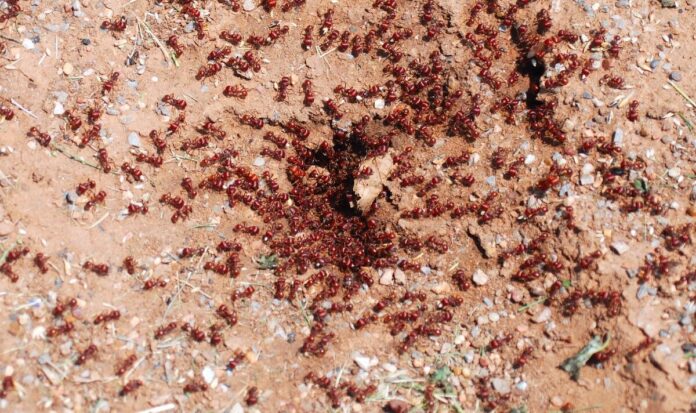A ‘supercolony’ of invasive ‘fire ants’, which can cause serious ecological harm and have a painful sting, have been discovered in France for the first time ever. The invasive species was only recently found at someone’s house in Toulon, a port city on the south coast, but it is thought that the creatures may have been there for years. The insects, which are native to South America, can deliver painful stings which can be felt for up to three hours, and even have the potential to cause blindness in household pets like cats and dogs. Only 1.5mm in size, the insects which have been dubbed ‘electric ants’ are thought to have been in France for at least four or five years, and in the past have been known to cause major disruption to native insect populations across North America, several Pacific Islands and parts of Australia.And worryingly, France is dealing with an invasion of a ‘supercolony’. Olivier Blight, a researcher at the Mediterranean Institute of Biodiversity and Ecology, was quoted saying: “We were already dealing with a super colony.”It’s just been identified but has been here around four or five years because there are already several hundred thousand, or even millions, of individuals over a hectare (2.5 acres).”Mr Blight added that the invasion of the dangerous ants came along with some plants too. The red ants are known for building large mound nests that are flattened, irregular in shape, and are between two to four square feet in size. Fire ants, an invasive species, have been detected in France (Image: Getty ) Fire ants are only around 1.55mm but pack a powerful sting (Image: Getty )They are normally introduced into new areas through potted plants, shrubs and trees, according to Pest World.org.The species of ant is said to be one of the most invasive species in the world, with its population threatening to reach 90 million individuals per acre.Mr Blight, warned that fire ant’s ‘strength is its number’ as the insects can multiply quicker than other species. The insects mix sexual and asexual reproduction, with queens producing clones without requiring fertilisation.While they are native to South America, the insects have been detected in Florida and Hawaii in the US, Israel, parts of West Africa, the Caribbean, Australia and many islands in the Pacific region.READ MORE: Defence system could ‘change Ukraine war’ and devastate Russia Fire ants are native to South America (Image: Getty )They are considered a major threat to the environment as they can destroy biodiversity by competing with, preying on and displacing native animals, ants and other types of insect.And this is also not the first time the fearsome little creatures have been detected in Europe, having previously been discovered in Malaga, Spain.According to a report published by the Ecological Society of Japan (ESJ), as of 2019 the fire ants had spread to more than 20 countries and territories in total. The first time the species was detected outside its native homeland was in the southern US back in the 1930s.The ESJ report notes that the species ‘has been classed as a ‘super pest’ because of its recorded, sometimes severe, impacts across a broad range of economic sectors, as well as on health, environment and lifestyle’.DON’T MISS Archaeologists stumble across vital across vital clue about Babylon [REPORT] RAF shoots down 53 drones in ‘message to Putin’ [INSIGHT] Heat pump scheme torn apart as Rishi urged to scrap ‘immoral waste’ [REVEAL] There is likely a “supercolony” in France (Image: Getty ) Their stings can reportedly blind cats and dogs (Image: Getty )This comes after a new study has revealed why there was a huge insect invasion in the UK over the summer, with experts warning that there will be more to come. While the UK has yet to see the dreaded fire ants hit its shores, a huge infestation of hoverflies arrived in the south west of England earlier this year, with Cornwall being the hardest hit by the invasion. Although the team at the University of Exeter found that the hoverflies were migrating after arriving in the Isles of Scilly before moving to the mainland, the insects reportedly arrived first from France – the place where the fire ants have just been detected. The report read: “Analysis of wind conditions revealed that the insects had most likely flown across the channel from Western France, a minimum distance of 200km.”Dr Karl Wotton, the University’s Senior Lecturer, added: ‘Studying insect migration is crucial if we are to fully reap the benefits of the ecological roles insects perform, from pest controllers and decomposers to pollinators. Understanding their routes and orientation mechanisms will help conservationists protect the large-scale movements of these insects.’
‘Supercolony’ of invasive fire ants with painful sting found in France
Sourceexpress.co.uk
RELATED ARTICLES


